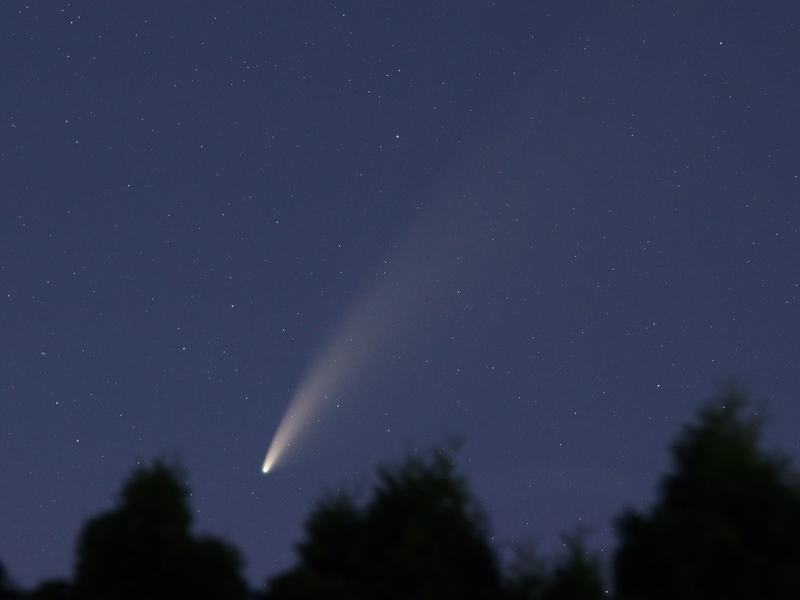
Few celestial objects excite the imaginations of stargazers and the general public like a good comet. The recent apparition of Comet C/2020 F3 (NEOWISE) prompted me to reflect on the all the comets I’ve been fortunate enough to see in the past 25 years. There have been some stunners, some surprises, and a few that could have been great, but fell short. Here’s my (highly subjective) pick of the five most interesting and spectacular comets from the past 25 years.
#5: Comet McNaught (January 2007)
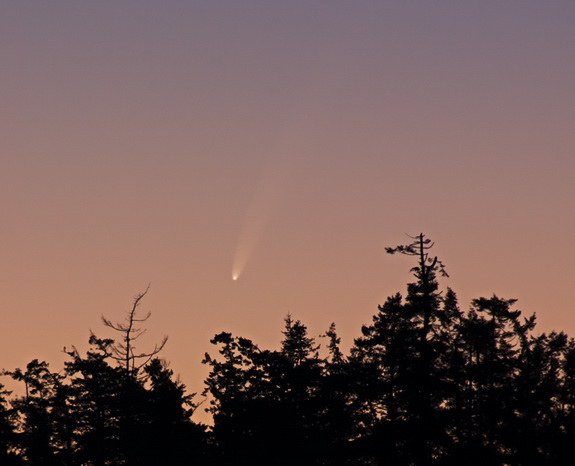
By some reckoning Comet McNaught (C/2006 P1), was a truly great comet. And if you live in the southern hemisphere, it likely tops your list. But I live in Canada. We didn’t get to view this comet until after perihelion, when the best part of the show was largely over. Even still, it was a splendid sight.
I’ll always remember trudging out to a nearby park in the crisp cold of a January sunset with my friend (and, at that moment, house guest) Rick Fienberg, former editor-in-chief at Sky&Telescope magazine. During a rare break in the overcast weather, we found our way to the top of a little, snow-covered hill with a good view across a nearby lagoon towards the west. We knew that the comet was going to be a real horizon scraper. We also knew that its visibility was going to be a race between fading daylight and the comet setting.
Rick spotted McNaught first when a nearby contrail from passing jet airplane caught his attention. That made it easy for him to point out the comet’s location to me, “just above the tree line to the left of the contrail!” Even though the sky was still very light, the comet was a snap to see once my eyes locked onto it. And as the sky grew darker, McNaught’s thin tail bloomed generously from a starlike coma. Memorable though it was, that proved to be my one and only glimpse of this magnificent visitor.
#4: Comet C/2020 F3 (NEOWISE)
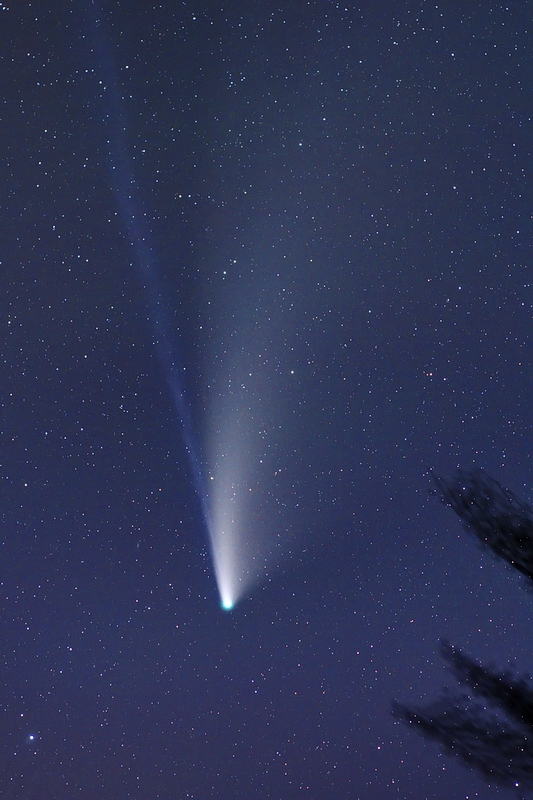
In spring of 2020, the appearance of a moderately bright comet began to feel like an eventuality. But each time a new one showed promise, it ultimately Kohoutek’d out, leaving disappointment in its wake. First it was C/2019 Y4 (ATLAS) and then it was C/2020 F8 (SWAN). Both initially looked good, only to fizzle out. So when Comet C/2020 F3 (NEOWISE) was discovered, most observers were leery. Twice bitten, thrice shy. With expectations set low, Comet NEOWISE arrived and ultimately delivered a grand show, far exceeding the hopes of even the most optimistic sky watchers. That’s why it ranks #4 on my list of the best comets of the past 25 years.
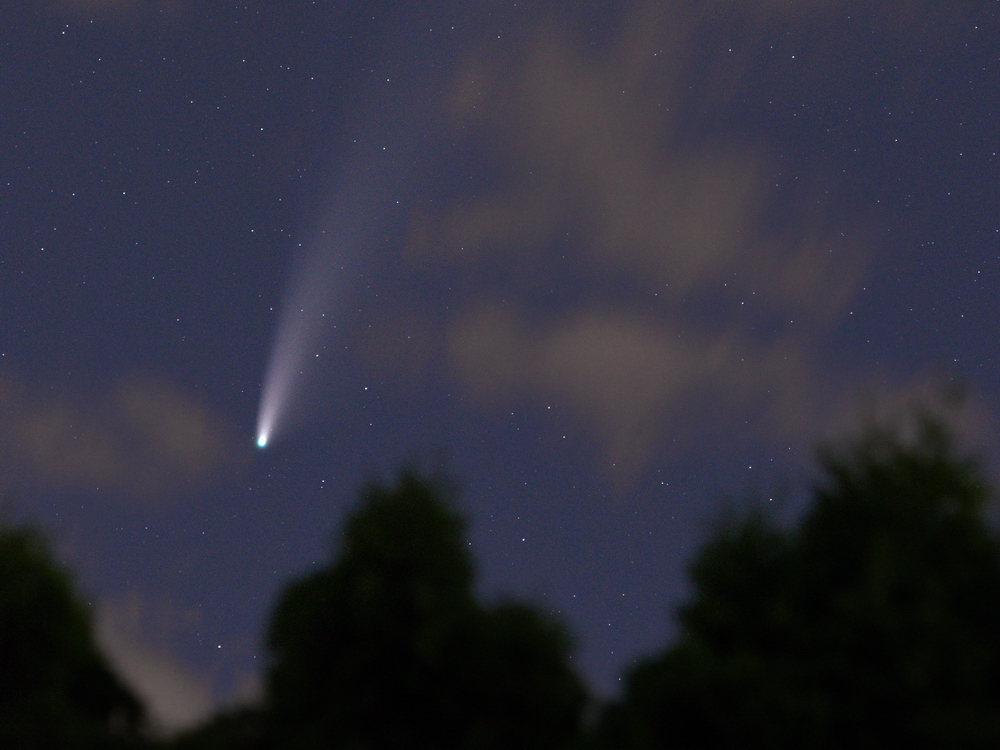
After several attempts thwarted by clouds, I got my first glimpse of NEOWISE on the morning of July 10th. It meant walking up my street, searching for a gap between the trees and houses for a view of the northeast horizon, where the comet was rising in small opening in the clouds during a rapidly brightening summer dawn. Thankfully, NEOWISE’s nucleus was bright — around 1st magnitude by my estimate. The only other thing I could see was the bright star Capella, in Auriga. The following morning I got my first good look at the comet and managed to see about 1° of tail in binoculars, despite the encroaching twilight.
As I’m not really a morning person, I was relieved when the comet transitioned to the evening sky. And for me, that’s when the fun really began. On July 14th I got my first really satisfying view — and the circumstances improved each subsequent evening as the comet climbed higher and higher as it also slanted westward. We had a run of good weather where I live, so I got to see and photograph the comet for several nights in succession. However, even as it climbed higher, NEOWISE was also starting to fade.
My very best views of the comet came during the July dark of the Moon, in the latter part of the month. I, along with some of my observing buddies, rented a set of cabins in a dark-sky location (taking care to socially distance as the dreadful COVID-19 pandemic was all the rage at the time). The comet was a lovely, featherlike apparition low in the north-northwest.

By the end of July, the best part of the show was over. The Moon was brightening the evening sky and the comet was fading as well. Although it was easy enough to see in binoculars, its tail was becoming difficult to perceive. And just like that — from first look to last glimpse in a matter of a few weeks. It seemed longer at the time, but then again, that’s the beauty of a bright comet — time seems to stand still, at least for a little while.
#3: Comet Holmes (2007/2008)
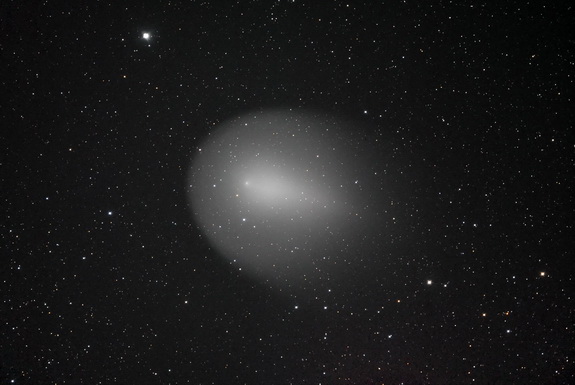
At any given time there are dozens of comets in the sky. Mostly they’re faint objects that never amount to anything terribly interesting. But every now and then, one of them does something completely unexpected and ends up being a real delight. If you believe that low expectations are the key to happiness, then you can appreciate the unexpected delight that was Comet Holmes (17P/Holmes).
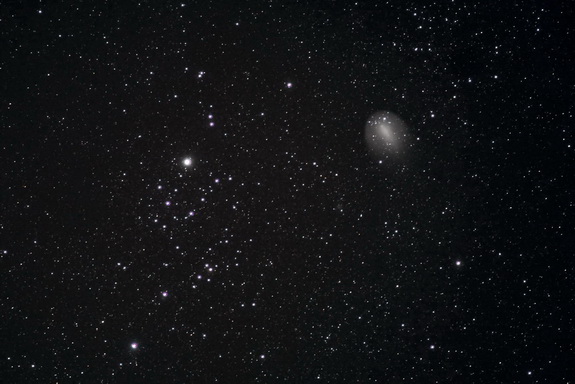
Comet Holmes wasn’t new — it was discovered back in 1892 — and initial predictions suggested a completely unremarkable 2007 apparition. At best, it had the potential to become a decent telescopic sight, though nothing to wake the neighbours over. But quite without warning, Holmes flared up and brightened from a dismal magnitude 14 to magnitude 3 in less than two days — a 25,000× increase!
My first encounter with Holmes came on the night of October 25th, the day after the flare-up was first noted. Even in twilight and under the light of a full Moon, Holmes was a conspicuous naked-eye object in Perseus. In a telescope, it looked like a pale yellow snowball with a star-like nucleus. Only a few nights later, the comet was distinctly non-stellar even to the unaided eye. In all the years I’d been watching comets, I’d never seen a transformation quite like it. And this was just the opening act!

Night after night I looked in on Comet Holmes and watched it grow larger and larger, and eventually, fainter and fainter. Over the following weeks and months, it continued to expand and eventually transformed itself from an intensely bright dot, to a big blob, to a mere haze so diaphanous and insubstantial that you could scarcely see it at all.
Perhaps no comet on this list so well illustrates comet discoverer David Levy’s aphorism that comets are like cats: they have tails, and they do precisely what they want. And in this case, that was a good thing!

#2: Comet Hale-Bopp (1997)

No one is going to be surprised to find this one near the top of my list, though some might wonder why it’s not #1. (You’ll find out why when you read about my #1 pick!) Hale-Bopp (C/1995 O1) was an amazing comet — a real stunner. And it’s the first comet to come along in my lifetime that managed to excite the popular imagination the same way Halley’s comet did. Sadly, some of this excitement lead to a tragic suicide cult and a lot of poor science reporting in the mass media. How little things have changed since 1910 when “mass hysteria” accompanied Halley’s appearance.
One reason Hale-Bopp was so widely noted was because it was so long in coming. American amateurs, Alan Hale and Thomas Bopp, first sighted the object in July 1995, and right away speculation began that it had the potential to be something really special. But it wasn’t due to be at its best until spring 1997. For backyard astronomers, it felt like having to wait nearly two years for Christmas!
I got my first look at Hale-Bopp while attending the Mt. Kobau Star Party in August 1995, a month after the comet’s discovery. At the time it was making its way through Sagittarius, but wasn’t a very impressive telescopic sight. And certainly the view didn’t suggest anything like the remarkable show that was due to unfold 15 months later.
Fast forward to the spring of ‘97, and I’m regularly observing the comet through the living room window of my downtown Vancouver apartment. How many comets can one expect to see naked eye from indoors under the light dome of a major city? And it wasn’t a case of just being able to see the comet — I was able to record fine detail. Even from that badly compromised observing site, I could make out the “shells” in the comet’s coma with my 3½-inch Questar telescope, perched on my apartment window sill. If you missed Hale-Bopp, you might be forgiven for suspecting that I’m indulging in a bit of cometary hyperbole here, but I’m not! And as impressive as the comet was from downtown, it was breathtakingly awesome under dark skies.
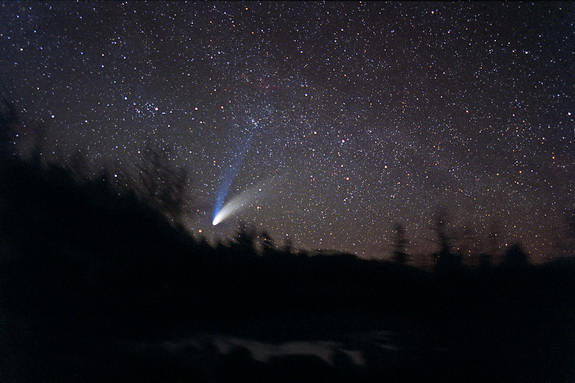
The weather gods smiled upon us during the peak of Hale-Bopp’s apparition and we had an uncharacteristic succession of clear skies over several nights. I fondly remember making treks to a dark-sky site north of Vancouver (halfway to Whistler) to photograph the comet and soak in the view. Hale-Bopp had an intensely bright nucleus and two bright, distinct tails. Indeed one night’s session was among the most memorable I’ve ever experienced.
Our observing spot was next to a railway line that saw very light traffic at night. But there was one train that came through pretty much once every evening. Those of us who used the site regularly got used to shielding our eyes from the locomotive’s impressively bright headlight whenever the train thundered by.
One night, while observing Hale-Bopp, we heard the unmistakable rumble of a distant train. Like a bunch of trained monkeys, we turned our backs to the track, covered our eyes, and waited for the train and its blinding light to go by. But this time, something was different. It just didn’t sound right. The train seemed to take forever to reach us, and when it finally did, we could hear the high-pitched squeal of train wheels slowly grinding to a complete halt. The train, and its 10-billion-candle-power light, had apparently broken down right next to our observing spot. How could this happen? Why here, why now? Suddenly, the false dawn from the train’s light vanished, and we heard a voice calling down from the locomotive. “Heard you guys might be viewing the comet . . . mind if we take a look?” With that, the engineer and his crew hopped down and joined us for a few minutes of comet watching. After a few minutes, they climbed back aboard their train and rumbled off on their way.
So, yes, it’s true. The allure of Comet Hale-Bopp was powerful enough to stop a locomotive. Now that’s a great comet!
#1 Comet Hyakutake (1996)
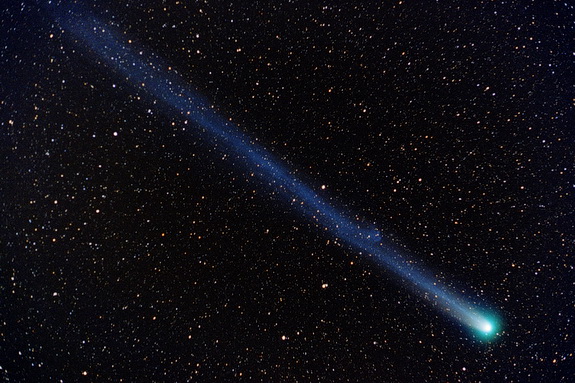
How do you quantify “best?” It’s always tough — especially when it comes to something that is purely a matter of visual appeal. Most would agree that the choice of best northern-hemisphere comet in the past 20 years comes down to choosing between Hale-Bopp and Hyakutake. For me Comet Hyakutake (C/1996 B2) was the better comet. It’s a personal thing for sure, and you had to be there . . .
Hyakutake felt like a gift. As we were biding our time waiting for Hale-Bopp to make its way to the inner solar system and live up to predictions, Hyakutake seem to come out of nowhere. While Hale-Bopp got all the press and public attention, Hyakutake was more like a private comet — a reward for the faithful who had endured a seemingly endless string of disappointments and no-shows that included Kohoutek in 1973 and Halley in 1986.
But above all, Hyakutake was visually stunning. In the same way the clothes make the man, the tail makes the comet. And Hyakutake had an extravagantly long, flowing tail. On the night of closest approach, its tail streamed more than 45°, from above the handle of the Big Dipper all the way down past Coma Berenices. Those of us lucky enough to enjoy the view from a dark-sky site were very much aware we were seeing an object of extraordinary rarity and magnificence. Add to that the brevity of its appearance, and you have all the ingredients for once-in-a-lifetime cometary experience.
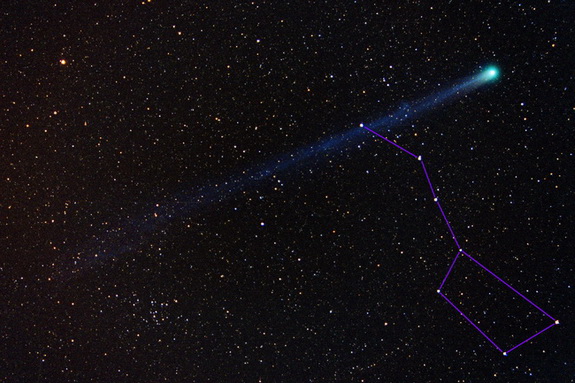
While Hale-Bopp took a long time to come and go, Hyakutake went by like a shot. Hyakutake was great for a few nights, it was unbelievable only for a single night — March 24/25 — when it had its closest approach to Earth. At our regular dark-sky site that night, there was an usually large crowd. It was just observers though — Hyakutake didn’t provoke the kind of public interest that Hale-Bopp would the following year.
When I arrived at the site and got out of my car, I looked up and was immediately stunned into speachlessness. My brain couldn’t believe what my eyes were telling it. Although I had seen the comet well the night before, the combination of a darker observing site and the comet’s proximity to Earth made the view startlingly powerful.
I vividly recall kneeling in the snow to align my telescope mount for the photographs you see here. It was a wonderfully clear, cold, crisp, and calm night that seemed perfect for comet viewing. High overhead, Hyakutake’s bright coma and diaphanous tail dominated the sky. It made the silence seem dramatic somehow — as though the comet should make some kind of whooshing sound, and the fact that it didn’t portended something ominous and rare. Hyakutake wasn’t just an object in the sky, it was more like a presence. And even as we looked up in awe and astonishment, we also felt sadness nibbling away at the edges of our perception. It was as if we collectively knew that this was a one-night-only show. I stayed with the comet until morning twilight, not wanting to let it go.
Two nights later I returned to the site hoping to recapture some of the magic from the previous session. I was the only one there — it felt like turning up for a parade the day after it had gone by. By then the comet was significantly diminished. But these things are relative — Hyakutake still had a tail that was 20° long!
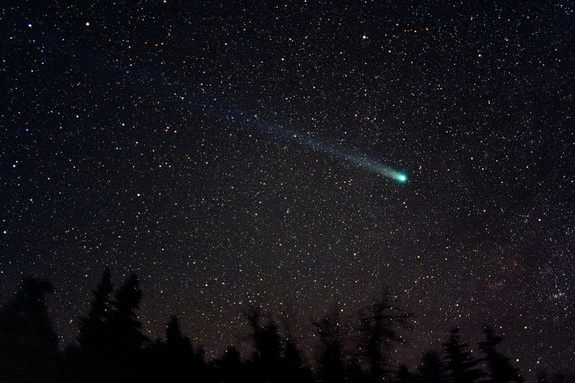
When I have a good night of stargazing, I feel as though I’m somehow connected to the larger universe — as if I’m in some small way a part of the same whole as the stars, planets, comets, and galaxies. The effect of seeing Hyakutake though changed that perspective. It was humbling. The comet simply and gracefully moved across the sky with quiet indifference. When it returns in 14,000 years, will anything of our time on this planet endure? Maybe, maybe not. Regardless, it won’t matter to the comet. As impressive as we found Comet Hyakutake, I’m pretty sure the feeling wasn’t mutual.
Honorable Mention: Comet PanSTARRS (March 2013)
To be honest, the main reason PanSTARRS (C/2011 L4) makes this list is because it was recent and because it was my #5 comet until it fell off the bottom of the list. Yes, PanSTARRS was reasonably bright, but years from now, I doubt I’ll still remember it. That said, it did put on a pretty good show in the spring of 2013 — I viewed and photographed it from my balcony in downtown Victoria, British Columbia. I doubt I’ll be able to say that about many comets.
I first laid eyes on PanSTARRS on March 12 while on my annual stargazing trip to a dark-sky site in Costa Rica. Along with a group of friends and fellow observers, I set up my camera and binoculars on a grassy hill overlooking the Gulf of Nicoya, and patiently waited in the relenting tropical heat and fading twilight for a shot at glimpsing the comet. PanSTARRS was just two days past perihelion, and on that evening was positioned near a fingernail-thin crescent Moon low in the west. Once I was able to find the Moon in binoculars, sighting the comet was easy. It was slightly brighter than many had predicted and sported a short, thin tail — an adornment that all comets really need to look “right.”
Once I returned home to Victoria, I viewed the comet for several consecutive nights as it began its long, slow fade. Even after most people stopped looking, PanSTARRS hung around, gradually making its way northward and back to obscurity. In all, it was a satisfying, if not spectacular visitor.
Did you find this article interesting or helpful? If so, consider using this link the next time you shop at Amazon.com. Better yet, bookmark it for future use. Thanks to Amazon’s associates program, doing so costs you nothing yet helps keep this site up and running. Thanks!
